Performative Activism and Allyship
A study on performative actions related to the Black Lives Matter movement and Predominately White University institutional response
This research was presented at the Iowa State Conference on Race and Ethnicity (ISCORE) 2022.
As part of a team project, we conducted comprehensive research examining performative activism and allyship in the context of the Black Lives Matter movement, with a specific focus on institutional responses at Predominately White Universities (PWIs). This research project investigated how universities, particularly Iowa State University, responded to racial justice movements and whether their actions constituted genuine institutional change or performative gestures.
The study employed a mixed-methods approach combining quantitative survey analysis with qualitative content analysis of institutional statements. Our research revealed significant gaps between public-facing support statements and substantive policy implementation, providing a framework for evaluating the authenticity of institutional responses to social justice movements.
Table of Contents
- Main Goals
- Research Methodology
- Key Findings
- Institutional Response Analysis
- Visual Examples of Performative Activism
- Research Impact
- Learning Outcomes
- Project Impact
Main Goals
- Analyze performative activism and institutional responses
- Examine student awareness and understanding of performative activism terminology
- Investigate the prevalence of performative actions during the 2020 BLM movement
- Evaluate institutional responses to racial justice demands and policy implementation
- Assess the gap between performative statements and substantive institutional change
- Develop comprehensive research methodology
- Design and implement survey instruments for quantitative data collection
- Conduct qualitative content analysis of institutional statements and policies
- Establish comparative framework for evaluating institutional authenticity
- Create systematic approach to measuring performative vs. substantive actions
- Present findings at academic conference
- Prepare research presentation for ISCORE 2022 conference
- Develop visual examples and case studies for academic audience
- Contribute to broader discourse on institutional accountability
- Provide framework for evaluating university responses to social movements
Research Methodology
Survey Design and Implementation
The study employed a comprehensive survey methodology to gather quantitative and qualitative data:
- Target Population: University students and community members
- Sample Size: 23 participants with diverse demographic representation
- Data Collection: Mixed-methods approach combining statistical analysis and content analysis
- Analysis Framework: Comparative analysis of institutional statements versus actual policy implementation
Data Analysis Approach
- Quantitative Analysis: Statistical analysis of survey responses regarding terminology familiarity and action observation
- Qualitative Analysis: Content analysis of university statements and policy announcements
- Comparative Framework: Evaluation of institutional responses across different time periods and contexts
Key Findings
Terminology Awareness and Understanding
The research revealed significant gaps in understanding of key concepts:
- 78% of participants were familiar with both “Performative Activism” and “Performative Allyship”
- 18% were familiar with “Performative Activism” only
- 4% were familiar with “Performative Allyship” only
- 0% were unfamiliar with both concepts
This finding suggests that while the majority of participants were familiar with both terms, there was still a notable portion (18%) who only recognized performative activism, indicating potential gaps in understanding of performative allyship as a distinct concept.
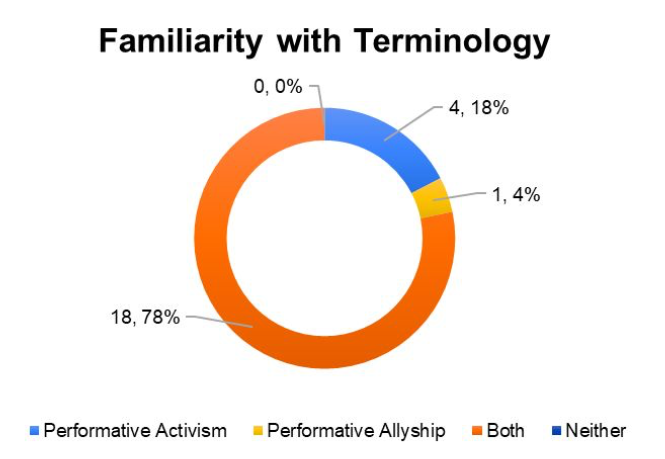
Prevalence of Performative Actions During BLM 2020
The study documented a significant increase in performative actions during the 2020 Black Lives Matter movement:
- 96% of participants observed increased performative actions during 2020
- 4% were unsure about the increase
- 0% reported no increase in performative actions
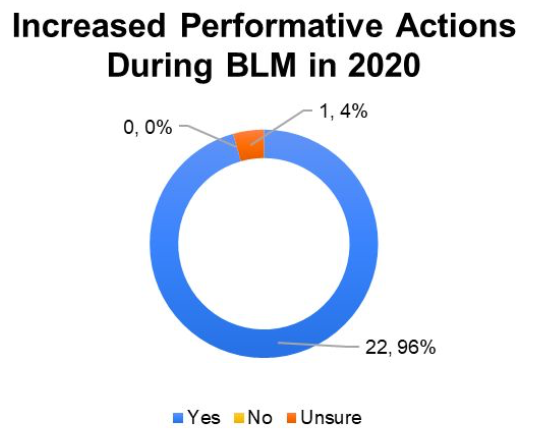
Geographic Distribution of Observations
Participants reported witnessing performative actions across multiple contexts:
- On-campus: University-sponsored events and statements
- Off-campus: Community and social media responses
- Both: Integrated institutional and community responses
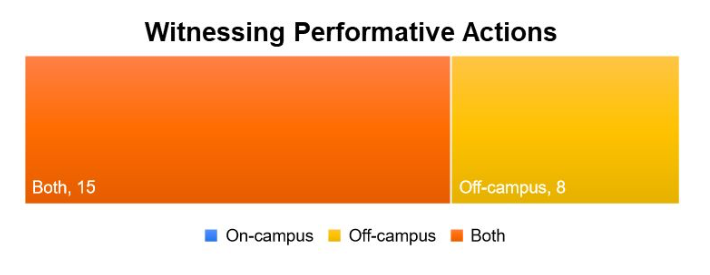
Institutional Response Patterns
The research identified specific patterns in how institutions responded to racial justice movements:
- Immediate Statements: Rapid response announcements following major events
- Policy Announcements: Long-term commitments that often lacked follow-through
- Training Initiatives: Cultural competency programs with varying implementation success
- Symbolic Gestures: Juneteenth recognition and holiday observances
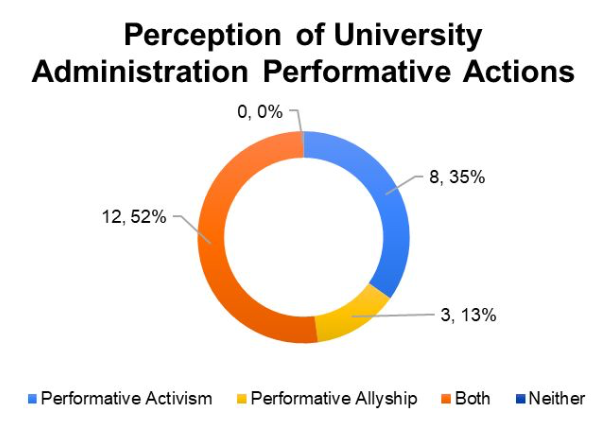
Qualitative Survey Insights
Beyond the quantitative data, our research captured valuable qualitative insights through open-ended survey questions:
Motivations for Performative Actions:
- Avoidance of Criticism: “People and big organizations do so to avoid criticism. Organizations also resort to this to boost publicity in hope of profit benefits”
- Social Image Management: “They don’t want to be viewed as ‘X’ or ‘Y’. For example, if they don’t participate they don’t want others to think they are racist, homophobic, etc.”
- Self-Serving Interests: “Self serving interests-to appear as ‘woke’”
- Lack of Personal Impact: “White people aren’t directly/personally impacted by racism, social injustices, or the danger that POC experience. Educating oneself to act beyond performative actions takes time and effort and I think a majority of people are lazy and only focus on things that directly affect the comfort of their own lives”
Consequences of Performative Actions:
- Trust Erosion: “It leads to a lack of trust. If people from marginalized identities encounter performative actions from people who claim to be allies, that relationship can be damaged. It also leads to a lack of actual progress”
- Accountability Issues: “Misinformation, lack of accountability”
- Trauma and Discrimination: “Negative impacts that results in additional trauma, discrimination, etc.”
- Masking Systemic Issues: “It masks the racism present on a campus, allows white folks (and others who hold dominant identities) to congratulate themselves for doing nothing, and can attract BIPOC and others who hold marginalized identities to an unsafe environment”
- Credit Appropriation: “Claiming the work of others/not properly giving credit where credit is due”
Solutions for Avoiding Performative Activism:
- Education and Understanding: “Educate people better on how to actually support communities”
- Accountability Measures: “Require actions and outcomes, accountability”
- Policy Impact Assessment: “Deeper understanding in the impact of the policies and procedures implemented”
- Listening to Marginalized Voices: “Listen to the issues people of color are experiencing”
- Proactive vs. Reactive Approaches: “Avoid only making statements (from the university specifically) when there is a social expectation that they should. Be more proactive than reactive”
- Action Against Hate Speech: “There needs to be action taken against hate speech and other acts of violence against minority groups. We should not be taking courses on the 1st amendment just for the university to say that hate speech is okay”
Visual Examples of Performative Activism
Case Study 1: Viral Photo-Op Incident (2020)
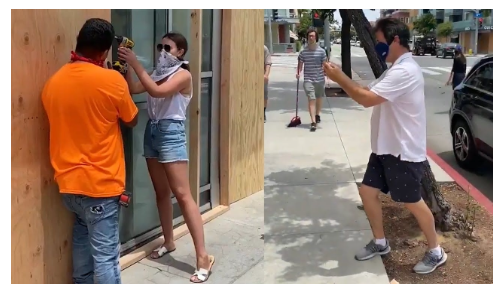
This widely circulated still from a viral video taken during the 2020 Black Lives Matter protests shows a woman posing with a power drill in front of a boarded-up storefront, appearing to help a construction worker while being photographed. After the photo was taken, the woman reportedly left without assisting further. This incident became emblematic of performative activism, where individuals appear to help for social media clout rather than genuine support. The scene was widely criticized online and discussed in news outlets as a prime example of the behavior critiqued in conversations about performative allyship during social movements.
Case Study 2: Bon Appétit Magazine Controversy (2020)

This composite image references the Bon Appétit magazine controversy that became a prominent example of performative allyship and systemic racism in media organizations. The left panel shows Bon Appétit’s public-facing Black Lives Matter support post stating “Food has always been political.” The middle panel features Adam Rapoport, then Editor-in-Chief of Bon Appétit. The right panel shows an Instagram post by Rapoport’s wife that resurfaced during the controversy, featuring racially insensitive content with hashtags like #boricua. Despite public statements supporting racial justice during the George Floyd protests, employees revealed widespread racial discrimination and pay inequity within the organization. This incident led to Rapoport’s resignation in June 2020 and exemplified how performative social media posts often lack the internal accountability and systemic change that true allyship requires.
Institutional Response Analysis
University Policy Announcements
The study analyzed Iowa State University’s response to student demands from October 30, 2019:
Announced Commitments:
- Cultural competency training for campus leaders
- Annual faculty training on inclusive classroom environments
- Diversity training for search committees
- Required DEI training for university housing students
- Pilot orientation course including DEI topics
Implementation Challenges:
- Limited follow-through on announced initiatives
- Inconsistent application across departments
- Lack of measurable outcomes and accountability
Juneteenth Recognition Analysis
The research examined institutional responses to Juneteenth recognition:
2020 Response:
- University acknowledgment of Juneteenth as a day of celebration
- Encouragement for community education and dialogue
- Reference to ISU’s Principles of Community
2021 Response:
- Guest essay by Senior Vice President Toyia Younger
- Connection to national holiday recognition
- Personal narrative integration with institutional messaging
George Floyd Trial Response
Analysis of institutional response to the Derek Chauvin trial verdict:
Key Elements:
- Acknowledgment of community pain and trauma
- Recognition of the personal impact on students of color
- Emphasis on emotional exhaustion and real fears
- Institutional support messaging
Research Impact
Academic Contributions
This research contributed to the broader academic discourse on:
- Institutional Response Theory: How PWIs respond to social movements
- Performative Activism Studies: Understanding the gap between rhetoric and action
- Critical Race Theory in Higher Education: Analyzing institutional racism and responses
Policy Implications
The findings have implications for:
- University Policy Development: Need for substantive rather than symbolic responses
- Student Affairs Practice: Importance of genuine institutional support
- Diversity and Inclusion Initiatives: Moving beyond performative gestures
Community Impact
The research provided:
- Student Voice: Documentation of student experiences and observations
- Institutional Accountability: Framework for evaluating university responses
- Educational Tool: Resource for understanding performative activism
Learning Outcomes
Research Skills Development
This project significantly enhanced my:
- Survey Design: Creating effective research instruments for sensitive topics
- Data Analysis: Mixed-methods approach combining quantitative and qualitative analysis
- Academic Writing: Presenting research findings at professional conferences
- Critical Analysis: Evaluating institutional responses and policy implementation
Subject Matter Expertise
Deepened understanding of:
- Social Movement Theory: How institutions respond to social justice movements
- Critical Race Theory: Analyzing racial dynamics in higher education
- Institutional Change: Barriers to substantive policy implementation
- Performative Activism: Distinguishing between genuine and symbolic actions
Professional Development
The research experience provided:
- Conference Presentation: Professional presentation at ISCORE 2022
- Academic Networking: Engagement with scholars in race and ethnicity studies
- Research Ethics: Navigating sensitive topics with appropriate methodology
- Community Engagement: Connecting academic research to real-world issues
Project Impact
This research project served as a comprehensive examination of institutional responses to social justice movements, providing:
- Academic Contribution: Original research on performative activism in higher education
- Policy Framework: Model for evaluating institutional responses to social movements
- Student Advocacy: Documentation of student experiences and institutional accountability
- Educational Resource: Tool for understanding performative activism and allyship
The project demonstrated the importance of moving beyond symbolic gestures toward substantive institutional change, while providing a framework for evaluating the authenticity of institutional responses to social justice movements. The research experience reinforced my commitment to using academic inquiry to address real-world social issues and promote institutional accountability.